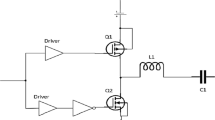Abstract
In this paper, we present analysis, design and show experimental results of a new type of CMOS based power amplifier (PA) known as class-O Aref et al. (ISSCC Digest of Technical Papers, 2015). Modern CMOS based PAs design is constrained by three fundamental trade-offs, i.e. linearity, efficiency and reliability. More precisely, for a standalone PA, unless advanced and expensive solutions are employed, no such PA architecture exists which is able to meet aforementioned design trade-offs. Theoretical insight is needed to understand the origin of performance trade-offs and the possible solutions to counter them. Class-O is a novel out-of-the-box solution to meet these tough challenges. Our prototype amplifier is a highly linear low-band 706 MHz 4G long term evolution (LTE) compatible class-O RF power amplifier in 130 nm CMOS technology for handheld wireless applications. The class-O architecture uses two sub-amplifiers working together as one grand PA. These two sub-amplifiers are common-source (CS) and common-drain (CD) amplifiers working in parallel feeding a common load with high linearity without the need for digital predistortion (DPD). The prototype chip is measured and characterized with continuous wave (CW), modulated signal and reliability measurements. With CW measurements, 1-dB compression point (P\(_{1\,{\mathrm{dB}}}\)) of 30.6 dBm and peak power added efficiency (PAE) of 45.2 \(\%\) is achieved. For the modulated signal measurements, the amplifier is tested with 16-QAM 20 MHz LTE signal with peak-to-average-power ratio of 6.54 dB. The amplifier meets the stringent LTE specs with an adjacent channel power ratio (ACPR) less than −30 dBc for both EUTRA and UTRA1 with average output power of 27 dBm and PAE above 20 \(\%\). Owing to the voltage following between gate source junctions in the common-drain amplifier in addition to cascode structure of common source amplifier, the stress is significantly reduced at the transistor terminals. The reliability is demonstrated by operating the amplifier in nominal and worst voltage-standing-wave-ratio (VSWR) conditions.















Similar content being viewed by others
References
Aref, A. F., Negra, R., & Khan, M. A. (2015). Class-O: a highly linear class of power amplifiers in 0.13 \({\mu }\) m CMOS for WCDMA/LTE Applications. In ISSCC Digest of Technical Papers.
Ruberto, M., et al. (2008). A reliability-aware power amplifier design for CMOS radio chip integration. In IEEE Reliability Physics Symposium (pp. 536–540).
Rezaei, M. J., et al. (2013). A review of intelligent predistortion methods for the linearization of RF power amplifiers. In International Conference on Computer Applications Technology (ICCAT).
Carneiro, M. L., et al. (2014). Fully integrated CMOS doherty power amplifier with network matching optimization for die size reduction. In 44th European Microwave Conference (EuMC).
Khan, M. A., Kalim, D., & Negra, R. (2011). Analysis and design of an unconditionally stable common-drain class-B RF power amplifier in 90 nm CMOS technology (pp. 1–4). Workshop on Integrated Nonlinear Microwave and Millimetre-Wave Circuits: INMMiC.
Khan, M. A., Kalim, D., & Negra, R. (2011). Study on load transformation networks for differential common drain class-B RF PA. In Proceedings of IEEE Semiconductor Conference Dresden 2011, Dresden, Germany (pp. 1–4).
Paidi, V., et al. (2003). High linearity and high efficiency of class-B power amplifiers in GaN HEMT technology. IEEE Transactions on Microwave Theory and Techniques, 51(2), 643–652.
Kang, J., Yu, D., Yang, Y., & Kim, B. (2006). Highly linear 0.18-\(\mu m\) CMOS power amplifier with deep n-well structure. IEEE Journal of Solid-State Circuits, 41(5), 1073–1080.
Dambrine, G., Cappy, A., Heliodore, F., Playez, E. (1988). A new method for determining the FET small-signal equivalent circuit. In IEEE Transactions on Microwave Theory and Techniques (vol. 36, No. 7).
Grebennikov, A. (2007). RF and microwave transistor oscillator design. Hoboken: Wiley.
Johns, D. A., & Martin, K. (2001). Analog integrated circuit design (1st ed.). New York: Wiley.
Chowdhury, D., Hull, C. D., Degani, O. B., Wang, Y., & Niknejad, A. M. (2009). A fully integrated dual-mode highly linear 2.4 GHz CMOS power amplifier for 4G WiMax applications. IEEE Journal of Solid-State Circuits, 44(12), 3393–3402.
Francois, B., & Reynaert, P. (2012). A fully integrated watt-level linear 900-MHz CMOS RF power amplifier for LTE-applications. IEEE Transactions on Microwave Theory and Techniques, 60(6), 1878–1885.
Kaymaksut, E., & Reynaert, P. (2014). A dual-mode transformer-based doherty LTE power amplifier in 40 nm CMOS. ISSCC Digest of Technical Papers (pp. 64–65).
Park, B., Wang, D., Kim, D., Cho, Y., Zhao, C., Kim, J., Na, Y., & Kim, B. (2012). A 31.5 %, 26 dBm LTE CMOS power amplifier with harmonic control. In European Microwave Integrated Circuits Conference (EuMIC) (pp. 341–344).
Kanda, K. et al. (2012). A fully integrated triple-band CMOS power amplifier for WCDMA mobile handsets. ISSCC Digest of Technical Papers (pp. 86–87).
Acknowledgments
This work is supported by the German Federal Ministry of Education and Research (BMBF) under Grant No. 03V023 “LeiCMOS”
Author information
Authors and Affiliations
Corresponding author
Rights and permissions
About this article
Cite this article
Khan, M.A., Aref, A.F., Tarar, M.M. et al. Analysis and design of class-O RF power amplifiers for wireless communication systems. Analog Integr Circ Sig Process 89, 317–325 (2016). https://doi.org/10.1007/s10470-016-0815-0
Received:
Revised:
Accepted:
Published:
Issue Date:
DOI: https://doi.org/10.1007/s10470-016-0815-0




